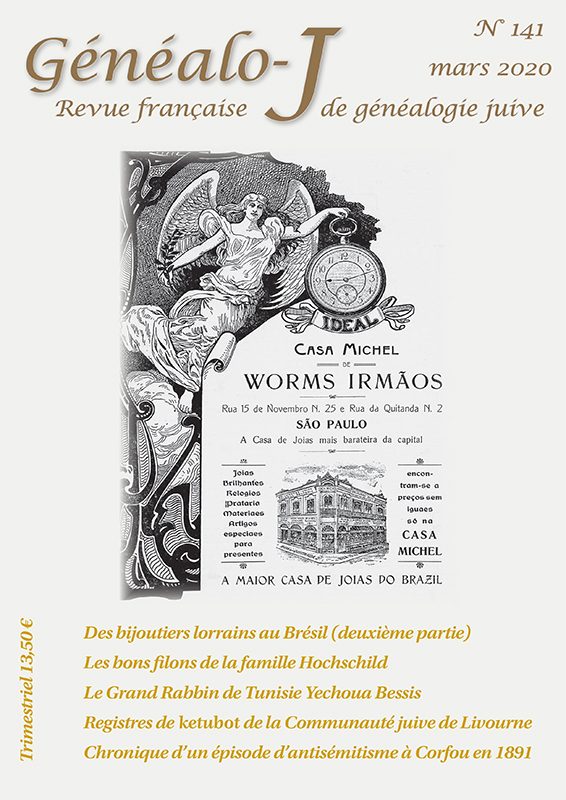
ABSTRACTS
Anne Marie Fribourg
Jewellers from Lorraine to Brazil (2nd part)
In this second part of the article published in Généalo-J n° 140, we meet mainly families from Hellimer who have settled in different parts of Brazil and especially in Manaos (Amazonia). These are the Worms, Nora, Schill, Kahn and Polack families.
Laurent Moyse
The good veins of the Hochschild family
At the beginning of the twentieth century, German Jews by the name of Hochschild resided in Metz. Two members of this family were recruited in 1914 as soldiers in the German army and fell on the battlefield. Originally from Hesse, the Hochschilds also scattered in America where they distinguished themselves in trade and industry.
Thierry Samama
Great Rabbi of Tunisia Yechoua Bessis (1773-1860) was he from Algéria?
R. Yechoua Bessis (1773-1860), born in Tunis, Head Rabbi of Tunisia, is one of the most famous and venerated Tunisian rabbis. The anniversary of his death is still celebrated on 9 tevet. However a notarial act, kept in the French Diplomatic Archives and unearthed by the author, suggests that the father of R. Yechoua was born in Algiers. This document requires careful analysis. It is published and evaluated for plausibility. We draw genealogical consequences, and publish a descendant tree of R. Yechoua Bessis.
Gilles Boulu, Alain Nedjar, Liliane Nedjar, Raphaël Attias
Records of unpublished Ketubot of the Livorno Jewish Community (1626 -1890)
The authors report the discovery of an exceptional source for genealogy: an almost complete series of ketubot registers of the Jewish Nation of Livorno, containing more than 6800 acts, from 1626 to 1890. The authors have translated these marriage contracts in a book to be published by the CGJ. This work, which also contains the reconstruction of the journey and the genealogy of 30 families as well as onomastic and statistical data, is the continuation of previous publications devoted to the Portuguese Jewish community in Tunis. The range of research then extended not only to Italy, but also to North Africa and the Ottoman Empire.
Florence Géry
Chronicle of a dramatic anti-Semitic episode in Corfu in 1891
On April 1891 in the small island of Corfu, on the eve of Passover, Rubina Sada – an eight years old Jewish girl – is murdered. The murder of Rubina, wrongly depicted as a christian martyr, is immediately blamed on the jewish community as a ritual crime. Infuriated, local christians subject the jewish neighborhoods of Corfu to extreme violence. The Israelite Universal Alliance sends a special envoy, Semtob Joseph Pariente, to Corfu. In less than three months, Pariente, a master negotiator and diplomat, persuades the jews of Corfu to hold their grounds and stay on the island. The murder of Rubina – which never went punished, was intended to create anti-jewish agitation in an election period unfavourable to the local authorities.